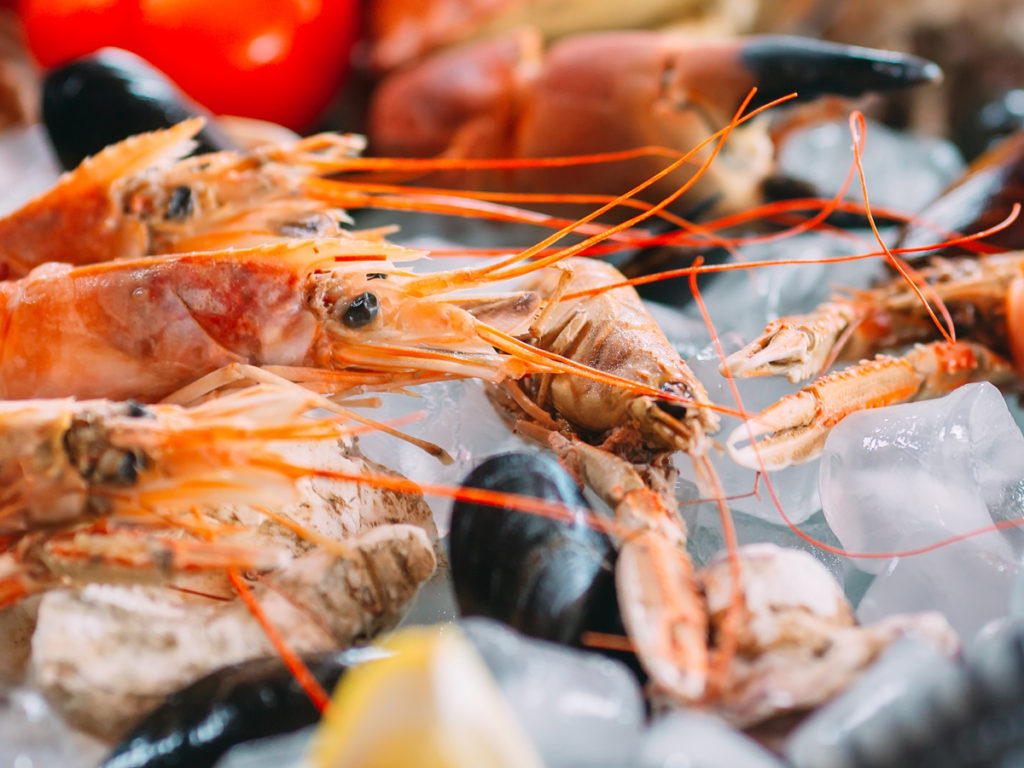Welcome to the second instalment of the Fish Face Seafood Blog Beginner’s Guide to Seafood. In our first blog post we looked at buying seafood. Our second blog post explores the topic of storing seafood.
Simply put, the best way to alleviate any fears over how to store seafood is to cook and eat it as soon as you can. Having said that, we understand that isn’t always possible.
Luckily, part two of our Beginner’s Guide to Seafood looks at the best ways of storing seafood.
#2 – The Fish Face Beginner’s Guide to… Storing Seafood

Preparation
It’s normal when cooking to prepare the ingredients in advance. You know the kind of thing, slice the onions, chop the garlic, skin the tomatoes etc…
With seafood, we need roll that preparation stage back a few hours. Seafood is a special ingredient. It needs to be looked after. That care and attention, or preparation, starts the minute it’s bought.
As a result, when visiting your fishmonger, try and go equipped with a cool bag. Better still, place a couple of freezer blocks in the bottom of the bag. The idea is to try and keep the temperature as low as possible.
Another tip is to buy your fish whole. Fish on the bone tends to keep better than when filleted. The added benefit here is you’ll also be able to make a good stock from the bones.
The star ingredient
Once you’ve bought your seafood, and placed it in your new cool bag, it’s best to get home as soon as possible. Let’s not forget, this ingredient is going to be the star of your dish. Let’s treat it like one. We don’t want it hanging around in the boot of your car. Let’s get it home.
Domestic fridges aren’t great for storing seafood. Therefore, any seafood, with the exception of Skate, is best eaten on the day of purchase.
Storing fish
However, we can employ a couple of things to slow down any deterioration. Gut the fish as soon as possible. While you’re at it, remove the scales and gills. Wash the fish, then pat dry with kitchen towel.
Once dry, place the fish in a shallow dish and wrap both the dish and fish in cling film and place in the coldest part of the fridge (which is normally the bottom shelf). Rick Stein suggests dotting cubes of ice on top of the cling film to keep the fish just that little bit colder.
Despite these efforts, it’s still best to use the fish on the same day as you bought it. Some fish deteriorate faster than others, so minimise any risk by using as soon as possible.
Storing shellfish
When it comes to shellfish, things are a little easier. Whether it be Clams, Mussels, Cockles etc… simply give them a good wash under cold water and place into a bowl. Place the bowl in the coldest part of fridge with a damp cloth on top. Do not soak or submerge in water any shellfish bought from your fishmonger. You’ll end up doing more harm than good.
Oysters can be stored in the same fashion, cup-side down.
Again, like all seafood, shellfish is best to eat on the day of purchase.
Storing Squid, Cuttlefish and Octopus
With Squid and Cuttlefish, we tend to prepare it as soon as we get home. Once prepared, we place it in an airtight container with a little salt and some olive oil. Again, we do it this way because we know we’re going to cook and eat the Squid within a few hours.
Octopus on the other hand will need to be tenderized. One way to achieve this is to place the Octopus into the freezer for a couple of weeks. Just be sure to clean and prepare it before doing so.
Storing Prawns
Depending on how we’re using them, we treat Prawns the same way. We shell them (keeping the shells for stock or to fry off) and then marinate them. White wine vinegar and a little salt is a good alternative to olive oil. Place everything into an airtight container and into the fridge.
Storing Crab, Lobster and Langoustine
Live Crab, Lobster and Langoustine should be wrapped in damp newspaper and placed in the bottom of your refrigerator. If a suitable size, the salad drawers make a perfect temporary home.
Live Crab and Lobster keep better than most seafood. However, it’s still best to cook and eat them as soon as possible. Keep an eye on your Crab – the meat deteriorates very quickly once it dies.
The exception
Now, you may have noticed we mentioned Skate earlier as the exception to the rule. Firstly, before buying Skate check the Marine Conservation Society’s Good Fish Guide for the latest sustainability ratings. Fish sold as Skate normally includes several species of Ray – some of which are threatened.

If you do buy Skate from a sustainable source, carefully check how fresh it is. Use your nose. If it smells strongly of ammonia, do not buy.
It’s also important to ask the fishmonger when the Skate was landed.
When super fresh, Skate is inedible, yet after a week or so it’s equally inedible, owing to the gradual build-up of ammonia. That leaves you a five-day window!
We hope you’ve found the Fish Face Seafood Blog Beginner’s Guide to Storing Seafood helpful. Keep a look out for the next blog post in the series. Hit the social media buttons below and follow us on Instagram and Twitter to stay up to date!